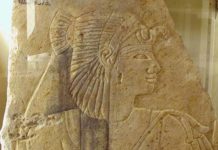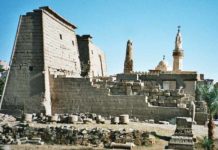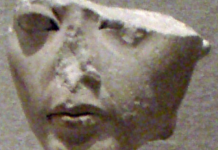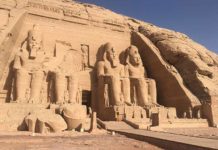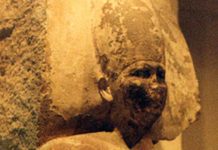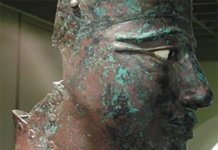Son of Seti I and one of the last pharoah’s of the New Kingdom’s 19th Dynasty, Ramesses II is one of the most widely recognized Egyptian rulers of all time, next to Tutankhamun. It is believed Ramesses II was born around 1300 BC and trained for his reign from an early age by being named as co-ruler of Egypt with his father when he came of the proper age. Eventually, Ramesses II came to rule Egypt on his own around the year 1279 BC
Traditionally, the transition period from one pharaoh to another gave neighboring empires the opportunity to rise against Egypt in the hopes of catching the great nation unprepared and focused on other matters. Ramesses II’s ascension to the Egyptian throne was no exception.
In the 4th year of his reign, Ramesses II set out with his armies to ward off the attacks of the Hittites. Unfortunately, the show of force he planned to exhibit was not to be and the ensuing conflict lasted nearly 20 years.
In one significant battle for the city of Qadesh, Ramesses II found his forces divided and on the run from the powerful Hittites. As the story goes, Ramesses II and his few personal bodyguards fought their way free from over 2500 Hittites. Ramesses supposedly escaped and re-grouped his forces to continue the fight.
In spite of this escape, the episode highlighted for Ramesses the fruitlessness of war with the Hittites. Ramesses II and the prince of the Hittites soon settled their differences in a peace agreement. Not only did they agree to mutual non-aggression, but they also agreed to help defend each other’s borders against the threat of common enemies.
Ramesses’ unsuccessful military campaigns apparently convinced the monarch he was more of a lover than a fighter. Ramesses spent the rest of his life building, in one form or another. Experts estimate Ramesses had over three dozen wives who gave him over 100 sons and more than 50 daughters. Many of Ramesses II’s wives were close relatives and there are indications he may even have married some of his daughters. This phenomenon, which we now consider to be the highly taboo concept called “incest”, was common practice in Egypt and throughout other parts of the world during this time.
Ramesses II not only concentrated on building a large family, but on building a name for himself as a living deity. Since he could not create a persona for himself worthy of deification through military actions, he created this desired public persona by building temples, adding to old structures and inscribing his name on almost every available inch of stone in Egypt. Ramesses II added to the temple of Amenhotep III, finished the construction of the great hall of columns at Karnak and created the Great Temple and the Temple of Hathor at Abu Simbel.
Abu Simbel
In another effort to solidify his position as supreme ruler in Egypt and abroad, Ramesses II ordered the Great Temple at Abu Simbel constructed, c. 1250 BC . The temple was built with four great seated statues of Ramesses II facing the East. These four statues were cut directly from the sandstone of the Nile riverbank and are about 66 feet or 20 meters in height. Two statues flank each side of the entrance to the temple proper. One statue, was damaged in centuries past, possibly by an earthquake, and is now missing its head and most of its torso.
The façade of the temple is further decorated with a carving of Re-Horakhte, one manifestation of the Egyptian sun god, above the doorway to the inner chambers and a row of baboons at the top of the façade. A cartouche bearing the Egyptian name of Ramesses II is carved above the doorway to the temple and smaller statues of Ramesses’ mother, “Mut-tuy”, his wife, Nefertari, and their many children stand between the legs of the immense statues of Ramesses.
The Great Temple at Abu Simbel is another testament to the great engineering and scientific minds of the ancient Egyptian Empire. The temple is dedicated to Ptah, Amun-Re, Re-Horakhte and Ramesses II, the greatest importance being placed on the sun god and Ramesses II. Abu Simbel is situated so that on two days each year, February 22, thought to be Ramesses’ birthday, and October 22, the day Ramesses ascended to the throne, the sun shines through the doorway of the temple and into the innermost sanctuary, lighting the seated statues of Ptah, Amun-Re, Re-Horakhte and Ramesses II. Ramesses II forever intertwined his image with that of the sun in the construction of this temple.
Those stepping inside the Great Temple are confronted with an almost square Main Hall lined on both sides with 30-foot statues of Ramesses II as Osiris, the Egyptian god of the dead. The statues on the northern side of the hall are carved wearing the crown of Upper Egypt and those on the southern side wear the crown of Lower Egypt. This symbolizes Ramesses’ control over the entire kingdom. This Main Hall is approximately 54 feet wide and 58 feet long. Three doors at the far end of the hall lead into other chambers.
The central door leads deepest into the solid rock from which the temple was carved. The door opens into a kind of foyer or vestibule adjacent to the most sacred site in the temple complex, the shrine containing the seated statues of Ptah, Amun-Re, Ramesses II and Re-Horakhte. This sanctuary is 185 feet deep into the rock and is still able to be almost magically lit by the sun’s morning rays twice each year. An amazing accomplishment considering the time and tools used by the Egyptians.
The Temple of Hathor
The smaller of the two temples at Abu Simbel is the Temple of Hathor, dedicated to Ramesses II’s favorite wife, Nefertari, who died in the 24th year of his reign. Hathor is the Egyptian goddess of love and music, as well as the wife of the Egyptian sun god, Ra. It is believed the site at Abu Simbel was sacred to Hathor even before Ramesses II decided to honor her with a temple there. The building of this second temple serves only to bring Ramesses II and Nefertari closer to Ra and Hathor in spirit and legend, both pairs husband and wife, both pairs forever immortalized at Abu Simbel.
The façade of the Temple of Hathor is not as grand or as immense as that of the Great Temple, but it is nonetheless an example of the skilled craftmanship of which the ancient Egyptians were capable. Six colossal statues front this temple. Each side of the temple door is guarded by two statues of Ramesses II and one of Nefertari dressed as Hathor. The statues, which tower above the temple entrance at 33 feet high, are almost surrounded by smaller statues of Ramesses II and Nefertari’s children. Strangely, the statues of Nefertari outside this temple are equal in height to those of Ramesses II. This was rarely done in Egypt and may have been intended to show Ramesses’ love and respect for Nefertari.
The interior of this temple has only one hall and a small sanctuary. The walls are decorated with images of Ramesses II in battle with Nefertari looking on, Ramesses II being crowned by Horus and Seth and Nefertari before Hathor. The innermost sanctuary is dedicated to Hathor and pictures Hathor framed in reeds and Nefertari offering incense to her image. Ramesses is also pictured in this sanctuary worshipping before images of himself and also before images of Nefertari.
Lost in the Sand
As the Egyptian Empire began to decline, these temples on the southern border of the country were gradually forgotten. The temples fell into disrepair and the desert reclaimed the land. The Great Temple of Abu Simbel was barely visible for centuries, partially buried under tons of sand.
In 1813, Johann Ludwig Burckhardt, a Swiss researcher, was traveling down the Nile when he happened to see part of the façade of the Great Temple sticking out of the sand. His reports of the grandeur of the temples hidden in the Egyptian sand tempted many tourists down the Nile to catch a glimpse of the spectacular monuments. Unfortunately, the temple facades were often mostly obscured by sand and offered little satisfaction to those in search of the greatness obvious in the temples at Karnak and Luxor. In 1817, Egyptologist Giovanni Battista Belzoni conducted the first significant research and exploration at the temple complex at Abu Simbel. Sand and debris were cleared from the temples to allow access to tourists and researchers alike.
The Aswan High Dam and Saving the Great Temple
One could be led to believe that nothing could destroy these temples. The temples had survived earthquakes, wars and sandstorms, but their greatest threat was still ahead. In the name of progress, it was decided that the Nile floods must be controlled. A dam was proposed and work was begun at Aswan. As water began to back up into the reservoir now known as Lake Nasser, it became evident that something had to be done, or the Great Temple at Abu Simbel would be submerged by the rising waters.
The Aswan High Dam was to stand 364 feet high and run 12, 562 feet across the width of the Nile. The resulting reservoir, Lake Nasser, would slice almost 200 miles into Egypt and another 100 miles into The Sudan. Over 90,000 people had to be relocated to facilitate the building of this dam, which cost in excess of $1 billion to complete.
The Egyptian government pled the case of Abu Simbel to the United Nations Educational, Scientific and Cultural Organization (UNESCO) and soon an international call for help was being answered. The UNESCO campaign raised enough money to begin salvage work on the temples.
First, a suitable relocation site had to be found. Since the temples were originally situated so the Sun would light the innermost sanctuary of the Great Temple on two days each year, those supporting the relocation felt the spirit of the temple would be eternally dampened if the new site were not to take this special alignment with the Sun into consideration. So, the new site, approximately 200 feet higher up on the plateau, was finally selected for its similarity to the original.
Between 1963 and 1968, the temples were cut into some 16,000 blocks and carefully moved and reconstructed at their new home. Both temples were completely disassembled, catalogued, photographed, numbered and marked to ensure they could be re-assembled as exactly as possible. It took a team of workmen, engineers and scientists from all over the world until 1972 to complete the work on Abu Simbel. Today, the cuts in the stone are hardly visible.
Overall, this massive salvage project cost over $36 million dollars. But, it is a feat of which even Ramesses the Great would have been proud. In 1979, UNESCO designated the temples at Abu Simbel a World Heritage Site and the temples stand today prepared to greet the sun as they have for thousands of years.



